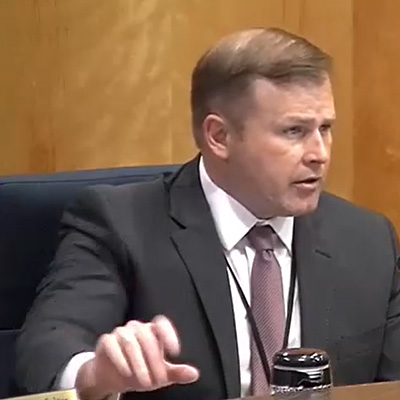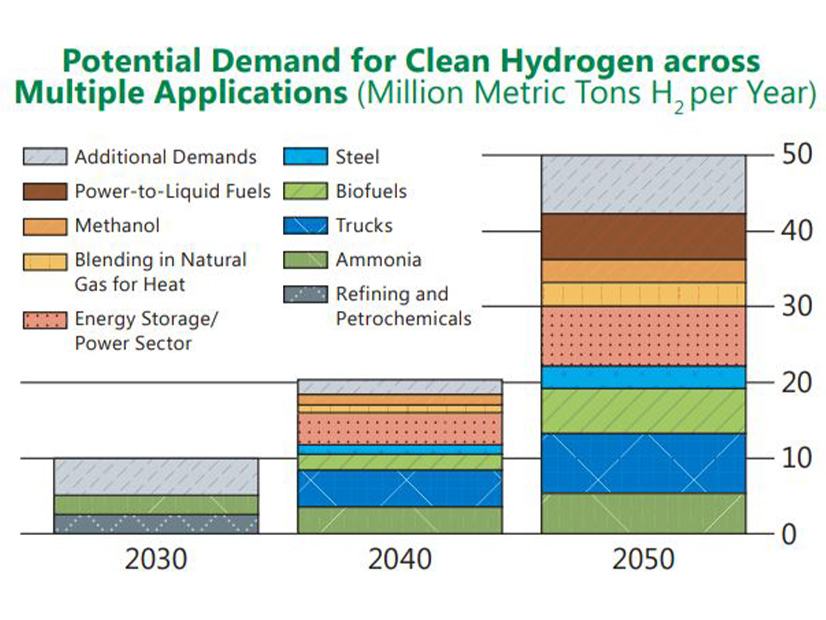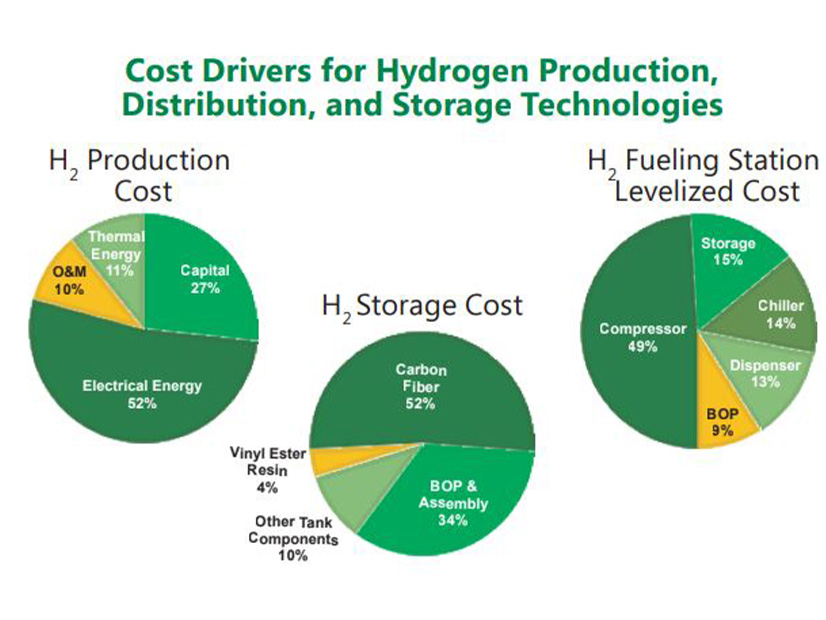Reaction to the Department of Energy’s hydrogen hub announcement Friday was swift and, in some cases, passionate.
Environmental advocates have been suspicious of or downright hostile to policymakers’ pursuit of hydrogen as a way to decarbonize sectors such as heavy industry and shipping.
Depending on how it is generated, it can carry a significant carbon footprint even as it displaces fossil fuels. And burning hydrogen is not an emissions-free process, even if it does not emit carbon dioxide. Of the seven hubs selected, four — the Appalachian, Texas, Midwest (Illinois, Indiana and Michigan) and Heartland (Minnesota, North Dakota and South Dakota) hubs — plan to use natural gas with carbon capture, or “blue” hydrogen. (See DOE Designates Seven Regional Hydrogen Hubs.) So it was no surprise that environmentalists pounced on Friday’s announcement, calling it “absurdly expensive,” “outrageous” and “reckless.”
But those advocating for hydrogen, particularly those on the winning side of Friday’s announcement, ranged from pleased to ecstatic by the promised investments and jobs.
Bragging Rights
Houston Mayor Sylvester Turner said his city, the center of the Gulf Coast Hydrogen Hub, “is uniquely able and willing to lead in the global energy transition.”
“There is no better place to produce American energy than in Texas,” said Texas Gov. Greg Abbott (R).
U.S. Sen. Joe Manchin (D-W.Va.) boasted in a news release that West Virginia, a part of the Appalachian Hydrogen Hub with Ohio and Pennsylvania, “will be the new epicenter of hydrogen in the United States of America.”
“As chairman of the Senate Energy Committee, I wrote and fought for the bipartisan infrastructure law to include $8 billion to establish hydrogen hubs to demonstrate the production and use of clean hydrogen — and now, West Virginia will be on the leading edge of building out the new hydrogen market while bringing good-paying jobs and new economic opportunity to the state,” he said.
Doubts on Carbon Capture
But Chelsea Barnes, director of government affairs and strategy for environmental group Appalachian Voices, expressed skepticism, saying DOE should invest in proven renewable energy technologies and “not further our reliance on methane gas.”
“While the hydrogen produced by these hubs will provide direct emissions reduction benefits to several forms of industry like chemical production and alternative fuels, the emissions reduction benefits are much more speculative for energy generation sites,” she said. “Carbon capture at these facilities is an unproven technology at this scale. There is only a modest reduction in greenhouse gas emissions from hydrogen blends.”
Seth Mullendore, president of the Clean Energy Group, which manages and staffs the Clean Energy States Alliance, a coalition of state energy organizations, said the hub announcement was “worse than expected.”
“We are particularly disappointed in the administration’s investment in blue hydrogen, which would more accurately be called fossil hydrogen with carbon capture. The fact that more than half the hubs will be using fossil gas is outrageous. This reckless buildout of hydrogen infrastructure does nothing to advance climate goals, and the related emissions will harm environmental justice communities.”
Mullendore cited peer-reviewed analyses that he said found that, even with carbon capture and sequestration, “the production and combustion of hydrogen derived from natural gas produces more greenhouse gas emissions than directly burning natural gas.”
“Current CCS technology can only capture about 55% of carbon emissions in the hydrogen production and combustion cycle, and it does nothing to stop fugitive methane emissions, which have a significant global warming impact. CCS also increases harmful particulate matter by up to 60%.”
Discord in California
The California Hydrogen Coalition was elated at the selection of the California Hydrogen Hub, saying it will “drive additional investment in the hydrogen infrastructure California and our nation need, securing California’s status as a leader in environmental innovation and policy.”
California Gov. Gavin Newsom (D) also celebrated, saying the hub “will cut pollution, power our clean energy economy and create hundreds of thousands of good paying jobs.”
But Food & Water Watch California Director Chirag Bhakta said the state should not be pursuing hydrogen production.
“Hydrogen is not a clean energy solution — and it is especially ill-suited for areas where water scarcity is a problem. Hydrogen is water intensive, which is particularly dangerous in a state that lacks water resiliency like California. Throughout its lifecycle, each megawatt-hour of ‘green’ hydrogen consumes at least 5,000 liters of water — far more than clean energy sources like wind or solar. California’s water supply is already at risk.”
Endangering the Great Lakes
Susan Thomas, director of legislation and policy/press at Just Transition Northwest Indiana, said steelmaking regions will not be well-served:
“Fossil fuel-produced hydrogen and carbon capture and storage will irrevocably endanger the Great Lakes ecosystem while further harming the region’s already overburdened communities. As a historic steel hub, Northwest Indiana is an epicenter in the fight for a just transition to renewable energy. We deserve the right to green jobs and a healthy environment, not more false solutions. These hydrogen hub announcements are more of the same carbon schemes from corporate polluters.”
Also critical was Julie McNamara, deputy policy director of the Climate and Energy Program at the Union of Concerned Scientists.
“Given the magnitude of investment, ambition and geographic reach of the H2Hubs program, the federal government holds enormous sway over the future direction of the hydrogen industry — with serious implications for climate, health and justice on the line,” she said. “Concerningly, today’s H2Hubs announcement advances multiple projects premised on fossil fuel-based hydrogen production and risky hydrogen end uses. Billions of taxpayer dollars are at risk of perpetuating fossil fuel industry injustices and harms while subsidizing fossil fuel greenwashing. This is an untenable point of focus for funds intended to spur the buildout of our clean energy future.”
David Schlissel, director of resource planning analysis at the Institute for Energy Economics and Financial Analysis, said his group’s research has shown that the government is “significantly understating the impact of producing blue hydrogen on global warming.”
“The reality is that blue hydrogen is not clean or low-carbon. Pursuing this technology is wasting precious time and diverting attention from investing in more effective measures to combat global warming like wind and solar resources, battery storage and energy efficiency.”
‘Significant Breakthrough’
Sasha Mackler, executive director of the Bipartisan Policy Center’s Energy Program, welcomed the news. “Today, we are on the cusp of a significant breakthrough in the pursuit of cleaner, more sustainable energy solutions,” she said. “The H2Hubs program represents a monumental stride towards harnessing the potential of clean hydrogen to decarbonize multiple sectors, address our pressing environmental challenges and launch a new clean economy.”
Lisa Jacobson, president of the Business Council for Sustainable Energy, called the announcement “an important milestone in building up the U.S. clean hydrogen industry and lowering emissions from hard-to-decarbonize sectors. Clean hydrogen is a critical tool in the broad portfolio of energy solutions our country needs to reduce carbon pollution, increase energy security, and create good-paying American jobs.”
North America’s Building Trades Unions President Sean McGarvey hailed the potential for organized labor.
“The future of hydrogen in the U.S. is now. The Department of Energy, through its commitment to expanding the deployment of this clean-burning energy resource, continues to demonstrate the Biden administration’s support of union workers. Through President Biden’s bipartisan infrastructure law, the establishment of regional clean hydrogen hubs will bolster communities and the environment and uplift America’s middle class with more building trades lifelong, sustainable career opportunities.”
Ben Hunkler, communications manager with the Ohio River Valley Institute, is skeptical about the economics of the still-developing technology, however.
“Methane-derived blue hydrogen — and the carbon capture that supports it — is economic for only a few niche industries. Investing in these unproven, absurdly expensive technologies risks locking our region into a gas-based economy that has proven incapable of generating sustained job growth and has placed community health and safety in harm’s way,” he said.
It Depends
Several commenters said it was too soon to tell if the initiative will be beneficial or not.
Holly Reuter, climate and clean energy implementation director at Clean Air Task Force, struck a tone of cautious optimism:
“This first-of-its-kind demonstration program presents real opportunities to position the U.S. as a leader in the clean hydrogen economy while helping us achieve our climate goals and improving public health. As attention turns to the next phase of planning, DOE, hub developers and states must be closely coordinated and transparent and seek external expertise as the hubs move forward. While this announcement is exciting progress, it is critical we get this program right. That means taking the time to engage with communities, experts, and other stakeholders to maximize the climate, economic, and public health benefits the hubs can provide.”
Jill Tauber, vice president of litigation for climate and energy at Earthjustice, wants to see more details.
“Hydrogen can be a clean energy solution, or it can drive us deeper into the climate crisis and hurt communities. Hydrogen produced from fossil fuels is not a solution — whatever the color,” she said. “Green hydrogen that is powered by new renewable resources can play an important role cleaning up what we cannot electrify, like steel manufacturing. Strong policies and smart, targeted investments can ensure the right path.”
She said her group will be evaluating the hub proposals and work “to ensure transparency, meaningful community engagement and full consideration of climate and community impacts. We will continue to fight against a fossil fuel buildout.”
Erik Kamrath, federal hydrogen advocate at the Natural Resources Defense Council, said “the stakes couldn’t be higher” with the development of the hydrogen industry.
“This provides an exciting stimulus for green hydrogen but includes a concerning focus on blue hydrogen and diverting clean energy sources that are currently powering our homes, which will make it a steeper path to align hydrogen to U.S. climate goals. We need the strictest possible guardrails to mitigate the risk of hydrogen stalling climate progress and perpetuating pollution and public health risks for communities on the frontline of the climate crisis. We need strong guardrails to ensure that U.S. hydrogen does not create an emissions mess and that we are not subsidizing hydrogen that is clean in name only.”



